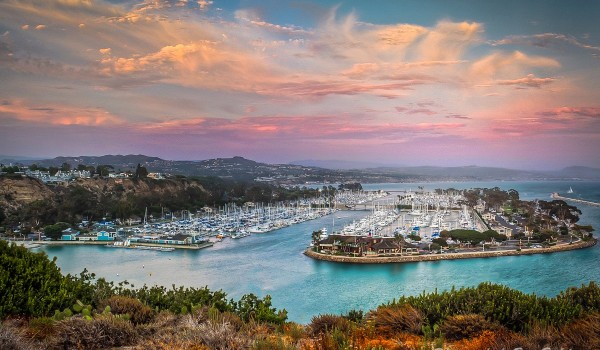
History
People of Dana Point have always looked to the sea. For centuries, perhaps thousands of years, Native Americans have watched from the headlands for migrating whales and trading canoes coming from other coastal communities and the Channel Islands to the shelter of the cove.
In the late eighteenth century, the first Europeans arrived. In 1776, Father Junipero Serra founded Mission San Juan Capistrano five miles inland from the coast. The mission was named for St. John of Capistrano, Italy, and the Spanish settlers named this entire area Bahia Capistrano, Capistrano Bay.
In 1818, Hipolito Bouchard, a pirate from Argentina, sailed his fleet to the cove at Dana Point. From here the pirates raided the mission.
In 1835, Richard Henry Dana, Jr. (1815-1882) shipped out on the Boston merchant ship Pilgrim, which sailed around South America’s Cape Horn bound for San Francisco. Pilgrim anchored the same cove as the pirates, but instead of raiding, they traded for cowhides, which factories bank in Boston would turn into shoes.
Dana related his adventures on the Pilgrim in the classic sea journal, Two Years Before the Mast, published in 1840 and still widely read today, especially in our state’s schools.
Dana describes the headlands and bay as “the only romantic spot on the California coast.” Residents returned the compliment in the late nineteenth century, shortly after his death, by naming the “Headlands” — the distinctive promontory jutting into the Pacific — Dana Point.
In the 1930’s, Sidney H. Woodruff, developer of the Hollywood tracts advertised by the Hollywood(land) sign, along with several prominent investors, purchased extensive land in the area and made ambitious plans for a resort town that combined the romance of Old California with modern amenities. The town was designed in a Spanish style, with wide streets and white adobe houses with red-tiled roofs. The street lights were molded on maritime signal lanterns, so early Dana Point streets were named after lanterns: “Street of the Blue Lantern” and “Street of the Golden Lantern” are examples. Development came to a halt with the 1929 stock market crash and subsequent Great Depression.
Another 1920’s development began in Capistrano Beach, led by oil tycoon Edward Doheny; it also faltered. In 1931, Doheny donated more the 40 acres of prime ocean front property to the state, which became Doheny State Beach Park, California’s first state beach.
In the 1950’s, pioneering surfers discovered Dana Point. In 1954, Hobie Alter, of Hobie Surfboards and Hobie Cat sailboat fame, opened the mainland’s first retail surf shop in Dana Point. Early surf legends came to ride “Killer Dana,” a legendary wave that broke at Dana Point Cove.
Construction of Dana Point Harbor started in the late 1960’s with the building of the rock breakwater jetties. Dana Point Harbor was officially dedicated on July 31, 1971. Inside its one-and-a-half mile jetty, the Harbor houses two marinas. The Harbor provides slips and mooring for over 2,500 boats along with more than 50 specialty shops and restaurants. Over two million visitors come to the harbor annually for shopping, dining, and enjoying a host of recreational activities.
In the 1970’s, residential development began in earnest and the sleepy beach town was transformed. In 1989, residents voted to incorporate as a legal city so they could have control of planning and development.
Today, Dana Point continues to improve services to residents and visitors alike, while preserving its history, scenic beauty, and unique character. The city is working to revitalize its Town Center, making it more pedestrian friendly and expanding the number of shops, galleries, and restaurants — plus, improving traffic and parking. Dramatic improvements are being made to the Harbor. The Dana Point Harbor Revitalization Plan calls for significant improvements, both in the water and on the land, to harbor and marina facilities and services, while maintaining the Harbor’s character and family atmosphere.
Demographics
| Population: | |
| Total: | 36,669 |
| Number of Registered Voters: | 22,756 |
| Median Age: | 41.5 Years of Age |
| Age Distribution: | |
| 00-14 Years 15-24 Years 25-34 Years 35-44 Years 45-59 Years 65+ Years |
16.4% 10.9% 12.5% 16.3% 29.6% 14.3% |
| Housing: | |
| Median Value, Single Family Detached: Median Value, Condo: Housing Units: -Single Units: -Multi Family: -Mobile Home: Average Rent: Owners: Renters: |
$912,500 $555,000 15,649 63.4% 34.2% 2.4% $1,471.00 61% 39% |
| Lodging Properties: | 15 |
| Rooms: | 1,935 |
| Businesses: | 1,351 |
| Median Household Income: | $73,125 |
| Labor Force: | 19,648 |
| Employment By Industry: | |
| Managerial/Professional: Sales/Admin. Support Service: Construction/Maintenance: |
42.5% 28.9% 14.5% 7.8% |
*Sources: California Department of Finance, Orange County Register, U.S. Census, O.C. Registrar of Voters



